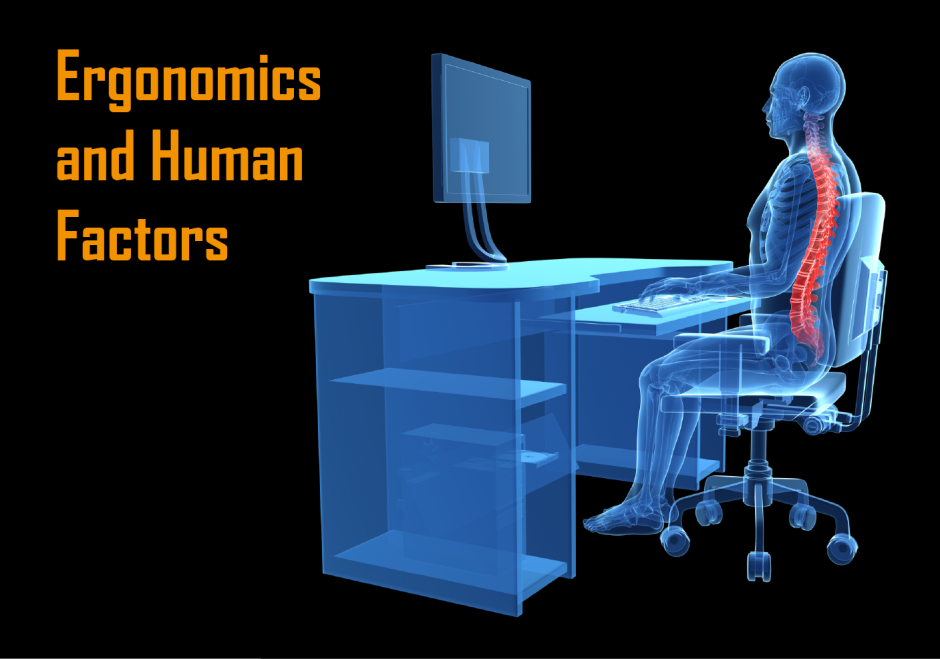
Ergonomics and human factors
The Health and Safety Executive (HSE (GB)) refer to ‘human factors’ as ‘the environmental, organisational and job factors, and human and individual characteristics which influence behaviour at work in a way which can affect health and safety’.
‘Ergonomics’ is concerned with the ‘fit’ between a person and their work.
Ergonomics is often divided into three main areas:
- physical ergonomics: focusing on the human body’s interaction with physical activities, such as posture, repetitive movements, and workstation design
- cognitive ergonomics: concerned with mental processes such as perception, memory, reasoning, and decision-making as they relate to system design
- organisational ergonomics: deals with optimising systems, structures, and workflows for better team dynamics and efficiency
Applying ergonomics and human factors in the workplace:
- puts emphasis on understanding the interactions between people, technology, and systems
- focuses on improving safety, usability, and performance by analysing human capabilities and limitations
- takes a broader systems approach, often considering not just physical and cognitive aspects but also cultural, social, and environmental influences on behaviour
Examples of industry application of ergonomics and human factors include:
- workplace design (for example, ergonomic chairs, standing desks)
- product development (for example, user-friendly interfaces, tool design)
- healthcare (for example, reducing medical errors, designing patient-centred systems)
- transportation (for example, vehicle cockpit layouts, road safety systems)
- aerospace (for example, improving pilot controls, reducing cognitive load)
A human factors (or ergonomics) approach focuses on how to make the best use of a worker’s capabilities by designing jobs and equipment which are fit for workers. It seeks to minimise discomfort, fatigue, and the risk of injury while maximising efficiency, productivity, and comfort.
Why should you consider ergonomics and human factors in the workplace?
Application of ergonomics and human factors in the workplace can help to:
- reduce accident potential
- reduce the potential for injury and ill health
- improve performance and productivity
Tailoring of tasks, equipment and workstations to suit the worker can help to reduce the potential of work-related ill-health conditions, such as:
Effective use of ergonomics and suitable matching of the job to the person will not only ensure that workers are not overloaded but will make work safer, healthier and more productive overall.
What should I do as an employer?


As an employer, you should assess the fit between a person and their work considering the worker’s physical and psychological characteristics with the task, the equipment being used, and the organisation and social environment.
Ergonomics and human factors should be considered at the start of the work design process, using appropriate expertise, with involvement from people with knowledge of the working processes, including:
- designers
- managers
- workers
- safety advisors / professionals, for example qualified ergonomist
It is possible to design safe, effective and productive work tasks and systems by assessing the abilities and limitations of workers, their jobs, equipment and working environment and the interaction between them.
Examples of important design factor considerations (whilst not exhaustive) include:
| Factor: | Consideration of: |
|---|---|
| Tasks should be designed in accordance with ergonomic principles considering the individual worker’s limitations and strengths Physical matching considers the workplace and working environment design Mental matching involves consideration of the worker’s perception of the tasks and risks, and their information and decision-making requirements There is potential for human error where there are mismatches between the task requirements and a worker’s capabilities Task design can have a direct effect on worker health and safety. Generally, people will try to adapt to a poor job, equipment or environment design, impacting on their health and safety, as well as the overall safety of the work system (for example, in major hazard industries) | Demands on the worker (workload, work pacing, shift timings, insufficient breaks, fatigue) Work equipment design and use (size, shape, controls, displays, suitably for the task) Information used (including accessibility, presentation, and how it can be changed) Physical environment (lighting, noise, temperature, humidity, vibration) |
| Factor: | Consideration of: |
|---|---|
| People vary in many ways: physically, mentally, personality, knowledge and experience An individual’s characteristics can influence their behaviour in the workplace Some characteristics such as personality are fixed; whilst others such as skills and attitudes may be changed or enhanced, such as competence and risk perception The varying range of physical and psychological abilities within a workforce should be considered in the design of plant and equipment used and tasks performed by workers | Physical differences - body shape/size, levels of fitness and strength, and capabilities Senses - variations in vision, hearing, and manual dexterity. For certain tasks, colour vision or visual acuity may be important and as such it will be necessary to ensure worker capability Mental abilities - can only really be assessed accurately using psychological testing however the demands/nature of tasks/work may require a specific level of ability Personality - can make a difference to the type of work that a worker is suited to and have more importance where a task/work has specific safety requirements Competence - workers will have varying levels of experience, knowledge, and training from which to draw on Disability - workers with disabilities may have specific needs. From an ergonomics perspective a disability is simply another individual characteristic to be considered when designing work tasks and systems |
| Factor: | Consideration of: |
|---|---|
| The characteristics of the organisation for which people work can affect behaviours in the workplace Organisational and social factors are often overlooked during the design process however can significantly influence worker behaviours For effective health and safety management, it is important to consider how organisational level influences may affect human behaviour | Communication Leadership Resources Work patterns Workplace culture |
Case study example
A corrugated box manufacturer examined the ergonomics of printing and die cutting machinery, and the distance workers were required to lift cardboard sheets from pallets placed at ground level before loading the sheets into a machine hopper.
The organisation identified that workers frequently adopted awkward postures, i.e., bending, twisting, and stooping, when carrying out the task due to the height of the cardboard sheets reducing on the pallets as they were being removed.
Through consideration of the work design, the organisation was able to remodel the pallets used to hold the cardboard sheets and install conveyor systems to transfer the pallets from the ‘Goods In’ area to a scissor lift table positioned at a level close to the machinery hopper for operator loading. As the cardboard sheet level reduced on the pallets, the scissor lift table level rose as the pallet weight decreased.
These design adaptions not only reduced pushing, bending and twisting by the workers but also increased machinery speed as loading was much easier and there were fewer stoppages moving material.
Typical ergonomic issues found in the workplace
Ergonomic issues in the workplace can cause physical injuries to workers such as back pain, upper limb disorders (ULDs) or other musculoskeletal disorders (MSDs), and may also increase the risk of slips, trips, and falls.
Ergonomic issues can also lead to stress, tiredness and/or fatigue, increasing the likelihood of accidents and ill health.
‘Typical’ ergonomic issues which can be found in the workplace include:
| Issue: | Example(s): |
|---|---|
| Poor task design | Work demands, i.e. either too high/low or conflicting priorities such as productivity/quality Workers having little input into their work organisation |
| Poor manual handling practices | Loads which are too heavy and/or bulky, placing unreasonable demands on workers Loads requiring to be lifted from floor level and/or above shoulder level Tasks involving frequent repetitive lifting Tasks requiring awkward postures, e.g. bending, twisting, stooping, or stretching Tasks being performed on uneven, wet, or sloping floor surfaces Tasks performed under time pressures and with insufficient rest breaks |
| Unsuitable workstation layout | Frequently used items which are not able to be conveniently reached Insufficient space for a worker to comfortably position their legs underneath the work surface Work surface height not suitable for the tasks being carried out resulting in workers adopting awkward and uncomfortable postures Inadequate lighting causing worker eyestrain when inspecting detail on work items Chairs not being properly adjusted to fit the person and workstation |
| Poor management of the working day | Insufficient recovery time for workers between shifts Poor shift scheduling Workers experiencing difficulties coordinating shifts with domestic responsibilities Excessive overtime working |
The HSE (GB) website provides further information relating to Human factors - Common risks and some industry specific ergonomics guidance information which can be found using the following links:
- Ergonomics: Agriculture - Machinery
- Ergonomics at materials recovery facilities
- HSE Offshore: Ergonomics checklists
- HSE Offshore: Ergonomics offshore
How can I identify if there are ergonomic and human factor issues in the workplace?


Ergonomics and human factors should be considered by employers as part of their normal risk assessment process.
The initial risk assessment step is hazard identification. Employers should seek the views of employees, conduct a walkaround of the workplace to spot any hazards, and review any previous accident history or reports of ill health.
Talk to workers
Worker collaboration helps organisation’s to practically manage workplace health and safety by:
- assisting the identification of workplace risks
- ensuring health and safety controls implemented are practical
- encouraging increased workforce commitment to safe and healthy ways of working
Workers have important knowledge of the work they do, problems they have, and their impact on health, safety, and performance. When collaborating with the workforce, ask specific questions about their work relating to ergonomics, for example:
- are their working postures comfortable (or not)?
- do they experience discomfort, aches, pain, fatigue, or feel unable to meet work demands?
- is the equipment suitable for their work, easy to use, and in good working order?
- are they satisfied with their working arrangements?
- do they repeatedly make the same errors or mistakes?
- are they able to follow work procedures, and if not, why not?
Effective consultation will require two-way communications between employers and workers, not only for information exchange but also for employers to listen to workers and take appropriate consideration of the discussion outcomes before making health and safety decisions.
Hazard spotting
Whilst walking around the workplace, look for signs of poor or inadequate equipment design, for example:
- improvised tools
- handwritten reminders/labels on equipment controls
- plasters on workers hands or ‘home-made’ protective pads worn by workers
Review
Review accident/ill health information available which may have been due to ergonomic and human factor issues in the workplace. For example:
- use information from accident reports to identify incident details and possible causes
- investigate the circumstances causing frequent errors or incidents
- look at identifying the root causes of worker mistakes
Record and look at sickness absence and staff turnover levels
High levels of sickness absence and staff turnover may be due to dissatisfaction at work and/or because of typical workplace ergonomic and human factors issues previously mentioned.
What you can do if ergonomic and human factor issues are identified in the workplace
- engage with the workforce from the outset to obtain and discuss possible suggestions, ideas and solutions - this should involve workers from the start of the process to facilitate the adoption of any work changes
- try to identify likely causes and possible solutions, a simple work alteration may be all that is required to perform a task easier and safer - for example:
- arrangement of frequently used and heavier items stored on shelving so that they are easily accessible such as between waist and shoulder height
- relocate the badly positioned controls or raise platforms so that they are accessible by workers
- facilitate leg room under work surfaces by removing obstacles
- provide height-adjustable chairs to facilitate individual operator work height preferences
- adjust shift work patterns
- introduce job/task rotation to reduce physical and mental fatigue
Employers must ensure that any work alterations are properly assessed and evaluated by workers involved in the tasks. Careful consideration must be given to ensure that any change introduced to solve one problem doesn’t create difficulties elsewhere.
Straightforward, inexpensive changes should be easy to identify, however assistance may be required from a qualified ergonomist where a solution is not identifiable or for more complex workplace issues.
Adopting an ergonomics and human factors approach in the workplace can help to avoid costly accidents, reduce injuries and sickness absence, improve quality and productivity, and save money in the long term.
Resources
- Back pain
- Ergonomic design of control centres - Principles for the design of control centres - (knowledge.bsigroup.com)
- Chartered Institute of Ergonomics & Human Factors (CIEHF) - (ergonomics.org.uk)
- Conveyor belt workstation design - (hse.gov.uk)
- DSE workstation assessment checklist
- Ergonomics free leaflets and publications - (hse.gov.uk)
- Ergonomics and human factors at work - a brief guide INDG90 -(hse.gov.uk)
- Good posture when using display screen equipment - MSD - (hse.gov.uk)
- Guidance on the prevention and management of musculoskeletal disorders (MSDs) in the workplace
- Hand Arm Vibration
- Human factors and ergonomics - (hse.gov.uk)
- Lighting
- Lower limb disorder
- Manual handling
- Safe computer use - (nidirect.gov.uk)
- Reducing error and influencing behaviour HSG48 - (hse.gov.uk)
- Safe use of Display Screen Equipment
- Safe use of work equipment. Provision and Use of Work Equipment Regulations: Approved Code of Practice and guidance L22 - (hse.gov.uk)
- Temperature and Work
- Upper limb disorders (ULDs)
- Whole Body Vibration (WBV)
- Working with display screen equipment (DSE) INDG36 - (hse.gov.uk)
- Work-related stress
- Workplace Health
Key Legislation
- Health and Safety at Work (Northern Ireland) Order 1978 - (legislation.gov.uk)
- Health and Safety at Work (Amendment) (Northern Ireland) Order 1998 - (legislation.gov.uk)
- Health and Safety (Display Screen Equipment) Regulations (Northern Ireland) 1992 - (legislation.gov.uk)
- Management of Health and Safety at Work Regulations (Northern Ireland) 2000 - (legislation.gov.uk)
- The Management of Health and Safety at Work (Amendment) Regulations (Northern Ireland) 2006 - (legislation.gov.uk)
- Provision and Use of Work Equipment Regulations (Northern Ireland) 1999 - (legislation.gov.uk)
- The Control of Vibration at Work Regulations (Northern Ireland) 2005 - (legislation.gov.uk)
- The Manual Handling Operations Regulations (Northern Ireland) 1992 - (legislation.gov.uk)
- Workplace (Health, Safety and Welfare) Regulations (Northern Ireland) 1993 - (legislation.gov.uk)
Please note that these links are to the original legislation, visitors should verify for themselves whether legislation is in force or whether it has been amended or repealed by subsequent legislation.